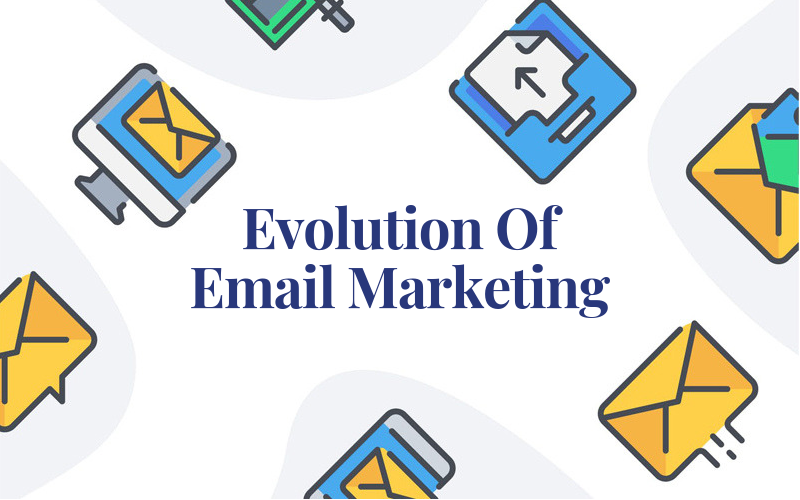The first-ever email was sent by Ray Tomlinson more than 42 years ago. Even though the history of email is one thing, the history, and evolution of email marketing are quite another. If you are an average business user, the Radicati Group report suggests that you receive 123 emails and send 33 every day.
The ability to send emails quickly and cheaply has made email marketing one of the most cost-effective methods of direct marketing. Not only is it a cheap and fast way of reaching consumers, but it means that we can react to consumer behavior in ways that we could not even dream of before.
Email has come a long way, and it not going anywhere. If you want to know a bit more about the evolution of email we are not only going to look at the history of email marketing but also ways that you can remain engaged and best practices for the future.
The Evolution Of Email Marketing
Even though the Internet was obviously readily available in the 1990s, business to consumer direct marketing primarily took place over the phone or used the traditional ‘snail mail’ variant. An email was mostly considered a way to communicate for corporate ends or for students. There was no widespread adoption of email because it was still new.
As email became used for personal communication, marketing professionals took notice. Many user’s inboxes suddenly became flooded with unwanted emails. The reason was simple: the early forms of email marketing showed tremendous promise, oftentimes with better results than traditional direct marketing.
Marketers understood that they could send ads, deals, and promotions directly to the customer with email. They suddenly no longer had to account for phone calls or printed materials: and those made up the bulk of their business-to-consumer marketing costs.
These unsolicited marketing emails led to the development of ‘spray and pray’ in email marketing. The method is rather simple: send emails out to as many addresses as possible, and hopefully eventually make a sale when people open the message. Emails were not targeted and the customer base not segmented.
As you might understand, those are not going to be successful methods in the long run. In fact, marketers have found that they need to evolve. That does not mean that e-mail marketing is going to go anywhere. In fact, email marketing is popular because it perfectly meets the changing needs of today’s on-the-go customer. Just consider this:
- It is instant – As a consumer, you instantly receive last minute deals and exclusive offers through e-mail. This allows companies to instantly get the word out with an opportunity to take advantage of a deal of saving some money.
- It is personal – The consumer of today is constantly flooded with marketing messages. That is why they respond best to those messages that are relevant and personalized. You can personalize your content and messages based on existing preferences.
- It is convenient – Few people lack access to email right on their smartphone. This is a type of communication that you always have available.
Call to actions
Your e-mail needs a call-to-action, something that you want the reader to do. When you do that, do not simply use a link, use a button instead. Not only are buttons clearer (because everyone knows what to do with a button) they are easier to click on a touchscreen device. This is going to help your prospect buyer move through the next step in the buyer’s journey as long as you have the button be large enough.
How to optimize your email conversion?
Given that we know where we stand as far as email is concerned, how can you stand out? How can you be one of the many emails that a user is going to read? We have a few different ways that you can optimize your email conversion and continue to evolve in your email marketing:
Segment your email list carefully
If you want to boost your conversion rate, you have to segment your email lists. We have previously discussed ‘pray and spray’ and consumers do not want to feel as though they are just another statistic. The following factors determine the caliber of your email list:
- The amount of segmentation of the list
- The effort and focus on attraction high potential readers/subscribers
- How often do you manage your list (e.g. remove inactive users and add new subscribers)
- The quality of your subscribers
If you need some help on how to segment your list, you can use the following criteria:
- Preference and interests
- Behavior
- Demographics
- Email data
When you use segmentation, sending tailored and more personalized email campaigns become easier. This means that your content is more relevant to the person receiving the email. This is going to help people be engaged. By segmenting your audience you demonstrate that they matter as individuals.
Automate your campaigns
If you want someone to take a specific action, you need to make them feel as though they are getting a response because of something they did. This creates a sense of immediacy with the user and will offer you better conversion rates. For example, you could automate a response with the following:
- Form submissions, visits or clicks
- A welcome mail when your prospect turns into a customer
- Welcome mail when someone subscribes to your blog
- Content downloads or page views.
- Inactive or dormant subscribes who do not engage you
Sending an upsell email as a past purchases trigger
While automated campaigns can be beneficial, they need to be relevant. This is about adding value to your recipients rather than having another way to engage. If you offer value it increases the chance of conversion.




